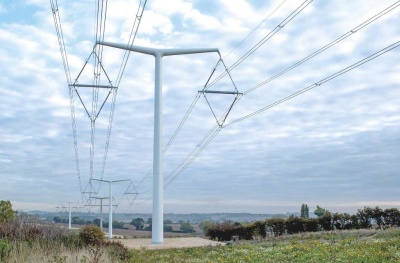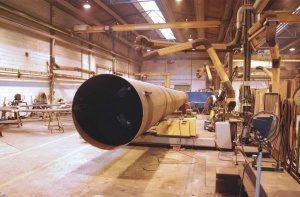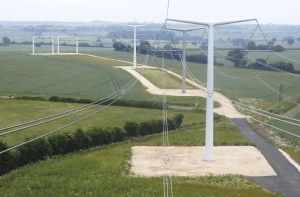Difference between revisions of "T-Pylon"
| Line 29: | Line 29: | ||
The new designs have significantly reduced maintenance requirements compared to traditional lattice towers. The durable [[Standard_corrosion_protection_systems_for_buildings| coating system]] and lack of edges and [[Construction#Site bolting| bolted connections]] increases the future maintenance intervals and makes re-painting the towers much faster. Also, no anti-climbing devices are needed for the monopole shaft, which would otherwise require frequent replacement. | The new designs have significantly reduced maintenance requirements compared to traditional lattice towers. The durable [[Standard_corrosion_protection_systems_for_buildings| coating system]] and lack of edges and [[Construction#Site bolting| bolted connections]] increases the future maintenance intervals and makes re-painting the towers much faster. Also, no anti-climbing devices are needed for the monopole shaft, which would otherwise require frequent replacement. | ||
| − | {|class="wikitable" width= | + | {|class="wikitable" width=500px |
|- | |- | ||
|'''Architect'''||Bystrup | |'''Architect'''||Bystrup | ||
Latest revision as of 12:34, 12 March 2019
Structural Steel Design Awards 2017 - Award
The T-Pylon is a structure of only few parts that can be erected quickly and requires virtually no maintenance. It is designed to carry 2 x 400kV, but can be modified to alternative specifications, and is the result of a design competition in 2011 to find a 21st Century power pylon design for Nationalgrid UK. The challenge was to find an alternative to conventional lattice towers that minimised the visual impact on the landscape, whilst being cost-effective and functionally superior.
The use of steel for the T-Pylon has allowed for unique geometries. Contrary to conventional lattice tower designs, the arms of the T-Pylon are slightly raised, which gives the pylon a more optimistic and positive appearance. The few parts making up the pylon have been welded together and subsequently painted white. The tower design is shorter and leaner than traditional lattice towers resulting in improved aesthetics and reduced environmental impact. The use of a monopile foundation also minimises the overall cost, installation time and environmental impact of the T-Pylon.
The alternative design using steel has made it possible to obtain the aesthetic and functional goal which is to minimise the visual impact on the surrounding landscape, while also providing an economic and durable solution.
The steel structure is designed in accordance with Eurocode 3 and fabricated in accordance with BS EN 1090-2[1] to Execution Class 3. The structural steel specification for the flanges, monopole and transition piece is for S355J2 to BS EN 10025-2[2] for thicknesses up to and including 50mm, and either S355NL to BS EN 10025-3[3] or S355ML to BS EN 10025-4[4] for thicknesses over 50mm. The steel plate also has to be accompanied by a Type 3.1 specific inspection certificate according to BS EN 10204[5].
A radical innovation is the re-assessment of the conductor/cable arrangement. The prismatic configuration of the cables allows a reduction in the pylon's height of more than 30%. The footprint of the power lines, as well as the electro-magnetic field (EMF) radiation, is thus reduced.
The most remarkable characteristic of the T-Pylon design is that all conductors are carried by a single attachment point. Traditionally, such a structure would have three separate arms - each carrying an individual conductor.
This unique attachment point was studied closely to ensure its robustness and resistance to fatigue. Complex analysis and physical loading tests were carried out to simulate climatic conditions such as extreme winds and ice loads. Investigations were made into the dynamic performance of the structure under simulated vibrations.
The pylon is made from S355 steel plates that are curved and welded to form cylindrical sections. The shaft is fabricated in either one or two pieces according to the length needed, the requirements for hot-dip galvanizing, and transport limitations. The steel plate thickness used for the shaft is optimised according to the design load cases and varies from 22mm at ground level to 14mm at the top.
At the top of the shaft a cast node connects the shaft to the two arms. The node is cast in one piece to ensure the optimal load transfer from the arms to the shaft. The result is a highly effective and smooth node that transfers the shape and forces from the arms to the shaft. The node is connected to the arms and shaft by non-visible internal bolts.
Dynamic external wind loads experienced on the pylon arms result in a bending moment at the pylon foundation. However, the cast node must withstand the transfer of internal stress from compression and tension at the node due to the pylon arm distributed load case. The cast node is designed to withstand both the magnitude and the dynamic behaviour of the load case.
At the end of the arms another node connects the insulator configuration to the arm in an aesthetically pleasing way. Again, the node is connected to the arms by non-visible internal bolts.
For the UK market, the pylon is hot-dip galvanized and painted light grey. This duplex coating system gives the pylon an expected lifespan of at least 80 years. For other markets the pylon can be produced in stainless steel or weathering steel.
The design of the shaft is similar to the design of towers for wind turbines. Consequently, it was possible for the steelwork contractor to use the experience from wind turbine towers to produce the shaft using automated processes in controlled factory conditions. Maximising the offsite fabrication simplified on-site operations and reduced the number of operatives required for the installation process.
The new designs have significantly reduced maintenance requirements compared to traditional lattice towers. The durable coating system and lack of edges and bolted connections increases the future maintenance intervals and makes re-painting the towers much faster. Also, no anti-climbing devices are needed for the monopole shaft, which would otherwise require frequent replacement.
| Architect | Bystrup |
| Structural Engineer | Bystrup |
| Main Contractor | Balfour Beatty Power Transmission & Distribution |
| Client | Nationalgrid UK |
Judges' comment
The T-Pylon represents a generational step change in power transmission hardware. Analytical design from first principles included re-examination of arrangements for insulation and maintenance.
The result is a family of compact pylons which can be deployed in sensitive landscapes, with prefabrication enabling consistent finish, smaller land take and speedy erection.
This is a steelwork design classic.
References
- ↑ BS EN 1090-2: 2008+A1:2011, Execution of steel structures and aluminium structures. Technical requirements for steel structures. BSI
- ↑ BS EN 10025-2: 2004, Hot rolled products of structural steels, Part 2: Technical delivery conditions for non-alloy structural steels, BSI
- ↑ BS EN 10025-3: 2004, Hot rolled products of structural steels, Part 3: Technical delivery conditions for normalized / normalized rolled weldable fine grain structural steels, BSI
- ↑ BS EN 10025-4: 2004, Hot rolled products of structural steels, Part 4: Technical delivery conditions for thermomechanical rolled weldable fine grain structural steels, BSI
- ↑ BS EN 10204:2004, Metallic products. Types of inspection documents, BSI






